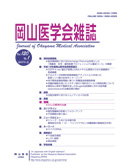

Journal of Okayama Medical Association
Published by Okayama Medical Association<Availability>
Full-text articles are available 3 years after publication.
Permalink : https://ousar.lib.okayama-u.ac.jp/16706
培養肝細胞の3'-Me-DAB処理による細胞悪性度の増強に関する研究 第2編 3'-Me-DAB処理の加算効果および病理組織学的検討
西山 正一
岡山大学医学部癌研病理部
発行日
1982-04-30
抄録
I reported previously that cell malignancy was promoted significantly by treatment with 3'-Me-DAB in the presence and absence of S15 mixture. In this report, I examined the effect of treatment frequency of 3'-Me-DAB in the presence and absence of S15 mixture on a cloned rat liver cell line (CL-20) which had low-tumor producing capacity. Tumors produced by subcutaneous back-transplantation of CL-20 cells treated with 3'-Me-DAB in the presence and absence of S15 mixture showed more undifferentiated, solid and infiltrative morphology than that of non-treated control cells. The tumors produced by back-transplantation of CL-20 cells treated with high concentrations of 3'-Me-DAB showed metastatic growth in the lung of rats, but those produced by back-transplantation of untreated CL-20 cells did not. Plating efficiency increased in proportion to the treatment frequency of 3'-Me-DAB in the presence and absence of S15 mixture. This fact suggests that plating efficiency is effective as a marker for the promotion of 3'-Me-DAB-induced cell malignancy. The aggregate sizes formed by the rotation culture were larger in the cells treated with 3'-Me-DAB in the presence and absence of S15 mixture than the control cells. However, the effect of the treatment frequency of 3'-Me-DAB was rarely found in this experiment. Few changes were observed with other in vitro markers for the promotion of cell malignancy. These findings suggested that cell malignancy could be promoted by repeated treatments of 3'-Me-DAB in the presence or absence of S15 mixture in vitro.
キーワード
発癌剤の処理回数
S15 mixture
病理組織学的所見
腫瘍の転移
Plating efficiency
ISSN
0030-1558
NCID
AN00032489
